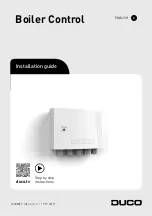
3064816_201804
53
Example
Limits in relation to specific system volume VA
(VA = system volume / max. rated heating output
1)
)
Total hardness conversion: 1 mol/m³ = 5.6 °dH = 10°fH
Total heating output
V
A
≤ 20 l/kW
V
A
> 20 l/kW und < 50 l/kW
V
A
≥ 50 l/kW
Total hardness /
total alkaline earths
Conduc-
tivity
2)
at 25°C
Total hardness /
total alkaline earths
Conduc-
tivity
2)
at 25°C
Total hardness /
total alkaline earths
Conduc-
tivity
2)
at 25°C
[kW]
[°dH]
[mol/m³] C [µS/cm] [°dH]
[mol/m³] C [µS/cm] [°dH]
[mol/m³]
C [µS/cm]
1
≤ 50
≤ 16.8
≤ 3.0
< 800
≤ 11.2
≤ 2
< 800
≤ 0.11
3)
≤ 0.02
< 800
2 50-200
≤ 11.2
≤ 2
< 100
≤ 8.4
≤ 1.5
< 100
≤ 0.11
3)
≤ 0.02
< 100
3 200-600
≤ 8.4
≤ 1.5
≤ 0.11
3)
≤ 0.02
≤ 0.11
3)
≤ 0.02
4
≤ 600 ≤ 0.11
3)
≤ 0.02
≤ 0.11
3)
≤ 0.02
≤ 0.11
3)
≤ 0.02
The total amount of fill and top-up water over the life cycle of the boiler must not exceed three times the nominal volume of the
heating system.
1)
According to VDI 2035, in systems with multiple boilers, use the maximum rated heating output of the smallest heat source
2)
High salinity < 800 µS/cm
Low salinity < 100 µS/cm
3)
< 0,11°dH recommended standard; permissible up to limit of < 1°dH
System with a CGS-2-20 system volume = 800 l
Total hardness of untreated potable water = 18°dH
V
A
= 800 l / 20 kW = 40 l / kW
Because the specific system volume VA is between 20 and 50 l/kW with a total output
of < 50 kW, the fill and top-up water must be in the range of 2 to 11.2°dH If the total
hardness of the untreated potable water is too high, some of the filling and top-up water
must be desalinated.
A% desalinated water must be added.
A = 100% - [(C
max
-0.1°dH) / C
potable water
- 0.1°dH)] x 100%
C
max
:
Maximum permissible total hardness in °dH
C
potable water
: Gesamthärte des unbehandelten Trinkwassers in °dH
A = 100% - [(11.2°dH - 0.1°dH) / (18°dH - 0.1°dH)] x 100% = 38%
38% of the filling and top-up water must be desalinated.
V
treatment
= 38% x 800 l = 304 l
At least 304 L of desalinated water must be added when filling the system.
The system can then be topped up with potable water.
Vent the system completely at the maximum system temperature.
The commissioning parameters must be recorded in the system log. This system log
must be handed to the system operator following commissioning of the system. From
that point onward, the operator is responsible for maintaining and keeping the system
log. The system log is provided with the accompanying documents.
The water values, in particular the pH value, electrical conductivity and hardness,
must be measured
annually
and documented in the system log.
The total amount of fill water used over the life cycle of the boiler must not exceed
three times the system volume (oxygenation!). Where a system requires large
volumes of top-up water (e.g. more than 10 % of the system volume per year), the
cause must be sought immediately and the fault remedied.
Commissioning
Top-up water
25. Filling the heating system/trap
















































